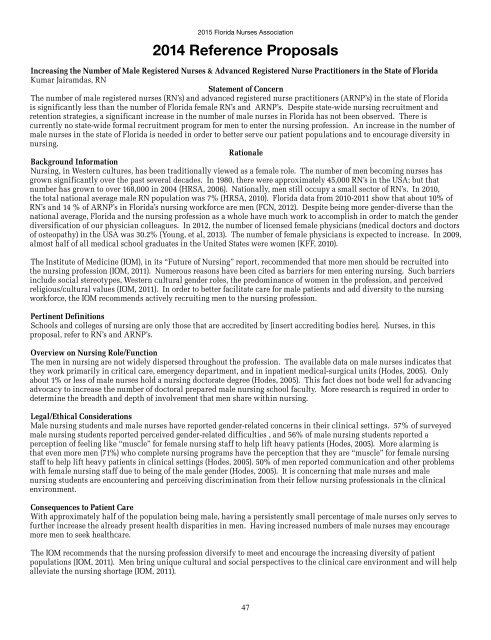2015 FNA Book of Reports
You also want an ePaper? Increase the reach of your titles
YUMPU automatically turns print PDFs into web optimized ePapers that Google loves.
<strong>2015</strong> Florida Nurses Association<br />
2014 Reference Proposals<br />
Increasing the Number <strong>of</strong> Male Registered Nurses & Advanced Registered Nurse Practitioners in the State <strong>of</strong> Florida<br />
Kumar Jairamdas, RN<br />
Statement <strong>of</strong> Concern<br />
The number <strong>of</strong> male registered nurses (RN’s) and advanced registered nurse practitioners (ARNP’s) in the state <strong>of</strong> Florida<br />
is significantly less than the number <strong>of</strong> Florida female RN’s and ARNP’s. Despite state-wide nursing recruitment and<br />
retention strategies, a significant increase in the number <strong>of</strong> male nurses in Florida has not been observed. There is<br />
currently no state-wide formal recruitment program for men to enter the nursing pr<strong>of</strong>ession. An increase in the number <strong>of</strong><br />
male nurses in the state <strong>of</strong> Florida is needed in order to better serve our patient populations and to encourage diversity in<br />
nursing.<br />
Rationale<br />
Background Information<br />
Nursing, in Western cultures, has been traditionally viewed as a female role. The number <strong>of</strong> men becoming nurses has<br />
grown significantly over the past several decades. In 1980, there were approximately 45,000 RN’s in the USA; but that<br />
number has grown to over 168,000 in 2004 (HRSA, 2006). Nationally, men still occupy a small sector <strong>of</strong> RN’s. In 2010,<br />
the total national average male RN population was 7% (HRSA, 2010). Florida data from 2010-2011 show that about 10% <strong>of</strong><br />
RN’s and 14 % <strong>of</strong> ARNP’s in Florida’s nursing workforce are men (FCN, 2012). Despite being more gender-diverse than the<br />
national average, Florida and the nursing pr<strong>of</strong>ession as a whole have much work to accomplish in order to match the gender<br />
diversification <strong>of</strong> our physician colleagues. In 2012, the number <strong>of</strong> licensed female physicians (medical doctors and doctors<br />
<strong>of</strong> osteopathy) in the USA was 30.2% (Young, et al, 2013). The number <strong>of</strong> female physicians is expected to increase. In 2009,<br />
almost half <strong>of</strong> all medical school graduates in the United States were women (KFF, 2010).<br />
The Institute <strong>of</strong> Medicine (IOM), in its “Future <strong>of</strong> Nursing” report, recommended that more men should be recruited into<br />
the nursing pr<strong>of</strong>ession (IOM, 2011). Numerous reasons have been cited as barriers for men entering nursing. Such barriers<br />
include social stereotypes, Western cultural gender roles, the predominance <strong>of</strong> women in the pr<strong>of</strong>ession, and perceived<br />
religious/cultural values (IOM, 2011). In order to better facilitate care for male patients and add diversity to the nursing<br />
workforce, the IOM recommends actively recruiting men to the nursing pr<strong>of</strong>ession.<br />
Pertinent Definitions<br />
Schools and colleges <strong>of</strong> nursing are only those that are accredited by [insert accrediting bodies here]. Nurses, in this<br />
proposal, refer to RN’s and ARNP’s.<br />
Overview on Nursing Role/Function<br />
The men in nursing are not widely dispersed throughout the pr<strong>of</strong>ession. The available data on male nurses indicates that<br />
they work primarily in critical care, emergency department, and in inpatient medical-surgical units (Hodes, 2005). Only<br />
about 1% or less <strong>of</strong> male nurses hold a nursing doctorate degree (Hodes, 2005). This fact does not bode well for advancing<br />
advocacy to increase the number <strong>of</strong> doctoral prepared male nursing school faculty. More research is required in order to<br />
determine the breadth and depth <strong>of</strong> involvement that men share within nursing.<br />
Legal/Ethical Considerations<br />
Male nursing students and male nurses have reported gender-related concerns in their clinical settings. 57% <strong>of</strong> surveyed<br />
male nursing students reported perceived gender-related difficulties , and 56% <strong>of</strong> male nursing students reported a<br />
perception <strong>of</strong> feeling like “muscle” for female nursing staff to help lift heavy patients (Hodes, 2005). More alarming is<br />
that even more men (71%) who complete nursing programs have the perception that they are “muscle” for female nursing<br />
staff to help lift heavy patients in clinical settings (Hodes, 2005). 50% <strong>of</strong> men reported communication and other problems<br />
with female nursing staff due to being <strong>of</strong> the male gender (Hodes, 2005). It is concerning that male nurses and male<br />
nursing students are encountering and perceiving discrimination from their fellow nursing pr<strong>of</strong>essionals in the clinical<br />
environment.<br />
Consequences to Patient Care<br />
With approximately half <strong>of</strong> the population being male, having a persistently small percentage <strong>of</strong> male nurses only serves to<br />
further increase the already present health disparities in men. Having increased numbers <strong>of</strong> male nurses may encourage<br />
more men to seek healthcare.<br />
The IOM recommends that the nursing pr<strong>of</strong>ession diversify to meet and encourage the increasing diversity <strong>of</strong> patient<br />
populations (IOM, 2011). Men bring unique cultural and social perspectives to the clinical care environment and will help<br />
alleviate the nursing shortage (IOM, 2011).<br />
47

















